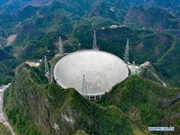

8) The Belt and Road Initiative served as pacesetter to an open economy that saw continuous improvement.
The Belt and Road (the Silk Road Economic Belt and 21st Century Maritime Silk Road) Initiative saw rapid progress. Development of the Initiative's framework, which consists of six corridors and six channels serving multiple countries and ports*, made steady progress, enabling China and its partners to markedly increase cohesion between their development strategies and plans. China-Europe freight train services, which have registered a total of nearly 3,000 trips, were brought under a single unified brand.
A number of signature projects for international industrial-capacity cooperation got off the ground. The Addis Ababa-Djibouti Railway officially came into service-from investment and financing to technology, operation, and management and maintenance, Chinese standards were applied throughout the project, making it the first full-production-chain export of China's railway. Steady progress was achieved in the construction of major international projects including railways connecting Jakarta and Bandung (high-speed railway), China and Laos, China and Thailand, and Hungary and Serbia; the railway project in southern Malaysia; and the Gwadar Port in Pakistan.
Further steps were taken to facilitate foreign investment, ensuring that utilized non-financial foreign investment remained stable. The regulation system and institutions for outbound investment were improved, which enabled further growth of outbound non-financial investment. All coastal ports installed and started using the Single Window System for foreign trade, and all ports throughout China successfully integrated customs clearance procedures and inspection and quarantine procedures.China experienced a 0.9% fall in total imports and exports for the year, which was 6.1 percentage points less than the previous year's decrease. Trade in services grew rapidly. The RMB was officially included in the International Monetary Fund's special drawing rights (SDR) basket. Of particular note was China's hosting of the G20 2016 Hangzhou Summit which produced important and far-reaching outcomes.
Box 7: Major Platforms for Development and Opening up
4. We deepened implementation of the innovation-driven development strategy, spurring the growth of new drivers for economic development.
The National Strategy for Innovation-Driven Development was published and implemented. With a number of major scientific and technological advances as well as rapid growth in high-tech industries, equipment manufacturing, and strategic emerging industries, innovation has played an increasingly important role in bolstering development.
1) Innovation capacity continued to improve.
We ensured the progressive and orderly development of major science and technology innovation platforms, and deepened pilot reforms on all-around innovation in eight regions. New strides were made in setting up science and technology innovation centers in Beijing and Shanghai. Work began to establish three national demonstration zones for the transfer and commercialization of scientific and technological achievements in Hebei-southern Beijing, Zhejiang, and Ningbo. The first national technology innovation center for high-speed trains was established, and the first Chinese-standard high-speed trains for which we hold complete intellectual property rights went into service. A number of major science and technology infrastructure projects were completed such as the project to build the world's largest single-aperture radio telescope, the Five-hundred-meter Aperture Spherical Telescope (FAST). A number of significant scientific and technological advances were achieved in sectors including quantum communications, space, and aviation.
We pressed ahead with implementing major national science and technology programs, and identified major projects for the Sci-Tech Innovation 2030 Agenda. A big push was made to encourage technological innovation among enterprises, with policies being implemented in relation to extra tax deductions for R&D costs, equity-based incentives for undertaking innovation, income tax incentives for personnel who contribute their technological achievements to become company shareholders, and improvements in the methods for defining new- and high-tech enterprises.
Box 8: Major Science and Technology Innovation Platforms
2) Entrepreneurship and innovation initiatives were carried out across the board.
Work on establishing 28 national entrepreneurship and innovation demonstration centers moved forward on all fronts. Information service platforms for entrepreneurship and innovation policies began operating, and a whitepaper on entrepreneurship and innovation was published. The national seed fund for investing in emerging industries, the sub-funds of the seed fund for encouraging the application of scientific and technological advances, and the National SME Development Fund all came into operation. Trials got underway to allow banks to make combined debt-equity investments in startups and small businesses, and creative improvements were made to the system of guaranteed loans for business startups. The second National Week for Entrepreneurship and Innovation and the Innovating China Tour were a tremendous success. 128 platforms for entrepreneurship and innovation were developed by large-scale central government enterprises, guidelines on further improving the policies for managing the funding of central government-funded research programs were published and implemented, and mechanisms for encouraging entrepreneurship and innovation were gradually improved in research institutes and universities. All types of incubators and professional maker spaces saw continuous development. On average, 15,100 new enterprises were registered each day in 2016.
3) New technologies and industries as well as new forms and models of business flourished.
There was rapid development in industrial robotics, integrated circuits, satellite applications, general aviation, bio-industry, and other new industries, while growth in strategic emerging industries was stable. In 2016, enterprises with annual turnover of 20 million yuan or more in 27 key strategic emerging industries increased their revenues by 11.32% and profits by 13.96%. We pressed ahead with implementing the Internet Plus initiative and the national big data strategy. Artificial intelligence, virtual reality, genetic engineering, and other new technologies experienced more rapid development. The platform, sharing, and collaborative economies, along with other new business models, achieved far-reaching penetration. New forms of business mushroomed, including combined online-offline businesses, cross-border and social networking e-commerce, smart home technology, and intelligent transportation. Online retail sales for 2016 reached nearly 5.2 trillion yuan, a year-on-year increase of 26.2%, with online retail sales of goods accounting for 12.6% of total retail sales of consumer goods.
4) Transformation and upgrading of traditional industries accelerated.
We moved faster to put the Made in China 2025 strategy into place, and organized implementation of the three-year action plan to enhance core competitiveness of our manufacturing industries and the project packages for transformation and upgrading of the manufacturing sector. The eight plans for industrial application were implemented smoothly. Major breakthroughs were made in research and development on key railway equipment. A total of 226 programs to run comprehensive, standardized tests on smart manufacturing technologies and apply new manufacturing models proceeded as planned. We made progress in building the National Robot Test and Evaluation Center. An investment fund for advanced manufacturing was set up.
* The six corridors refer to economic corridors, comprising the New Eurasian Continental Bridge, the China-Mongolia-Russia corridor, the China-Central Asia-West Asia corridor, the China-Indochina Peninsula corridor, the China-Pakistan corridor, and the Bangladesh-China-India-Myanmar corridor. The six channels refer to communications and distribution channels comprising highways, railways, airlines, waterways, pipelines, and information networks.
 |  |

 Award-winning photos show poverty reduction achievements in NE China's Jilin province
Award-winning photos show poverty reduction achievements in NE China's Jilin province People dance to greet advent of New Year in Ameiqituo Town, Guizhou
People dance to greet advent of New Year in Ameiqituo Town, Guizhou Fire brigade in Shanghai holds group wedding
Fire brigade in Shanghai holds group wedding Tourists enjoy ice sculptures in Datan Town, north China
Tourists enjoy ice sculptures in Datan Town, north China Sunset scenery of Dayan Pagoda in Xi'an
Sunset scenery of Dayan Pagoda in Xi'an Tourists have fun at scenic spot in Nanlong Town, NW China
Tourists have fun at scenic spot in Nanlong Town, NW China Harbin attracts tourists by making best use of ice in winter
Harbin attracts tourists by making best use of ice in winter In pics: FIS Alpine Ski Women's World Cup Slalom
In pics: FIS Alpine Ski Women's World Cup Slalom Black-necked cranes rest at reservoir in Lhunzhub County, Lhasa
Black-necked cranes rest at reservoir in Lhunzhub County, Lhasa China's FAST telescope will be available to foreign scientists in April
China's FAST telescope will be available to foreign scientists in April